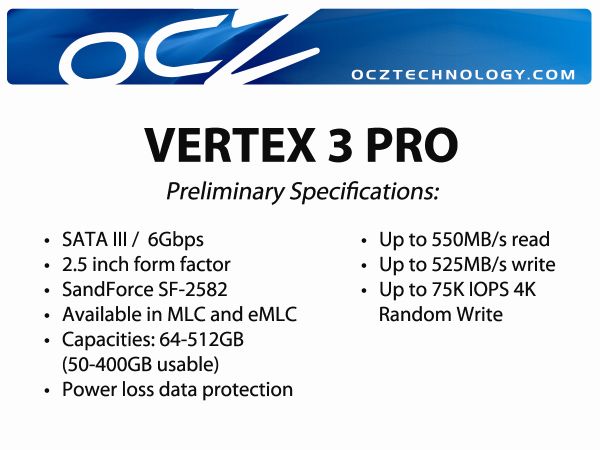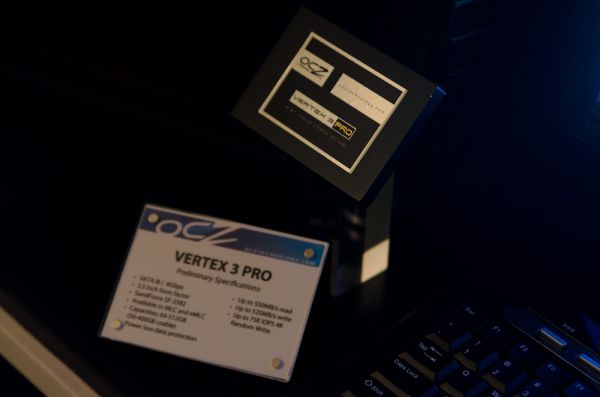OCZ'z Vertex 3 Pro Demo: World's First SandForce SF-2000
by Anand Lal Shimpi on January 5, 2011 9:37 PM ESTA few months ago SandForce announced its second generation SSD controller: the SF-2000 series. The specs SandForce released at the time were almost too good to be true. As a refresher here’s what we saw back in October of last year:

SandForce is promising a single enterprise level drive that can deliver 500MB/s sequential reads and writes (for highly compressible data), and up to 60K IOPS for 4KB random reads and writes. That’s not an evolutionary improvement, that’s more than a doubling of what most of the competition can do today. Even compared to existing SandForce drives it’s a huge increase in performance. But as I’ve heard many times before, anyone can put out a promising PDF.
Today at CES, OCZ previewed its first SF-2000 based drives: the Vertex 3 Pro and Vertex 3 EX. Both are based on SandForce’s SF-2582 controller, the highest end offering in the SF-2000 family. The drives won’t see the light of day for months (sometime in Q2) and what OCZ is showing today is very, *very* early silicon and hardware. The drives are using 32nm Toshiba toggle-mode NAND (effectively DDR NAND), however OCZ will go to market with 25nm Intel NAND when the drive is ready.
First let’s look at the specs OCZ is promising for these drives:
OCZ’s specs are even higher than SandForce’s. This is getting ridiculous. Thankfully, OCZ let me run some of my own Iometer tests on the drives to verify the claims. Surprisingly enough, the Vertex 3 Pro looks like it’s really as fast as OCZ and SandForce are claiming. When running highly compressible data (pseudo random in Iometer) at low queue depths, I get 518MB/s sequential write speed and nearly 500MB/s for sequential read speed. Remember this is the very first version of the drive and there’s months of tweaking ahead to get it ready for production. Performance may even increase by the time OCZ actually ships the drive. Furthermore, this is the performance of a single drive with a single controller - there’s no funny on-board RAID going on, we’re just talking about the performance of a single drive.
| OCZ Vertex 3 Pro Preliminary Test Data | ||||
| Iometer 2010 Test | Incompressible Data | Compressible Data | ||
| 128KB Sequential Write (QD=3) | 262.MB/s | 518.2MB/s | ||
| 128KB Sequential Read (QD=3) | 493.4MB/s | 492.3MB/s | ||
| 4KB Random Read (QD=3) | 186.5MB/s | N/A | ||
| 4KB Random Write (QD=3) | 162.7MB/s | 227.0MB/s | ||
Even if we look at incompressible data (fully random), the performance is unbelievable. You get better minimum performance on the SF-2582 than peak performance on the SF-1200/SF-1500. Note that we couldn't run all of our tests given the very early nature of the hardware sample. The fact that we could get these numbers at all on the first beta of the drive was beyond impressive.
Obviously to hit these speeds you need a 6Gbps controller. Thankfully there are at least a few ways to get those ports.
It’s looking like SandForce will be last to bring out their next-generation drive in the first half of the year with both Micron and Intel beating it to the punch, but if we can get this sort of performance, and have it be reliable, it may be worth the wait.


















62 Comments
View All Comments
goozira - Wednesday, January 5, 2011 - link
With the IBIS XL 5.25" drive, what connection ports are on the back and is the box completely enclosed? I'm wondering if OCZ made the unit upgradeable with slide-out PCB slots or would you have to buy different levels of storage like the Z-Drive.ckryan - Thursday, January 6, 2011 - link
I wonder if the next gen SF drives will be the next step in performance. Moving from an Agility or Vertex to a Agility 2/Vertex 2 isn't that big a step... certainly not the giant leap moving from a mechanical drive to a SSD was. I wonder if moving from a 2g Intel or Idilinx drive to a nextgen SF drive will seem like that large of a leap in tangible performance. Getting that kind of performance leap is addictive, and why I replaced the drives in my desktop and laptop with SSDs to begin with. Upgrading from SSD to a marginally faster SSD doesn't make much sense, but it certainly seems like the next generation of SF's may have the leap in performance to make the upgrade worth while.cactusdog - Thursday, January 6, 2011 - link
No doubt these are going to be much more expensive too but unless you move around a lot of 4GB+ files it probably wont be very noticeable with normal computer use over a fast sata 2 ssd.vol7ron - Thursday, January 6, 2011 - link
- "No doubt these are going to be much more expensive too"Maybe market prices. The NAND should be cheaper, it's the controller that's driving the price. I'm not sure if the SF-2K controllers will be all that much more than the 1500s were when they were released. If what the article posted is true, this is the best controller, so it certainly will be expensive. I'm curious how the lower (cheaper) SF-2K controllers fair in performance.
- "it probably wont be very noticeable with normal computer use over a fast sata 2 ssd."
Maybe, maybe not. I still notice a slowdown with Intel G2 during startup, just because of the massive amounts of startup apps and widgets that now exist.
With more screen real estate (those that have large/multiple monitors), you have more space to want to fill, and thus a larger demand on your hardware resources.
Though, I still have my anti-virus/games on a mechanical drive to increase the longevity of the SSD. I'm waiting for that $/GiB ratio to go down before thinking about putting them on SSDs.
Out of Box Experience - Saturday, January 8, 2011 - link
Can a single Vertex 3 copy and paste 4GB files faster than a modern 7200 RPM Western Digital?This could be interesting..
A modern Western Digital desktop drive is 3 times faster than a Vertex 2 at copying and pasting data but a vertex 3 isnt 3 X faster than a Vertex 2 so its still probably slower than a Western Digital at copy/paste functions..
You know, REALWORLD functions!
MrSpadge - Thursday, January 6, 2011 - link
The faster storage becomes, the more of a bottleneck the rest becomes. If your CPU is already at 100% there's only so much an even faster SSD can do. So don't expect another huge jump, but rather solid improvements.MrS
RussianSensation - Thursday, January 6, 2011 - link
Looks like SATA 3.0 is going to be obsolete by the time Vertex 4 rolls around. Unbelievable. I might just have to bite the bullet and finally grab an SSD drive, which of course means I have to dump my 1.5 year old S1156 platform with its by now archaic SATA 2.0 interface !probedb - Thursday, January 6, 2011 - link
Just buy a SATA 3.0 PCIe card :)therealnickdanger - Thursday, January 6, 2011 - link
Or avoid the whole mess and buy a Revo and get superior IO.Shadowmaster625 - Thursday, January 6, 2011 - link
Can you boot off a SATA 3 PCIe card? I mean without jumping through 17 hoops.